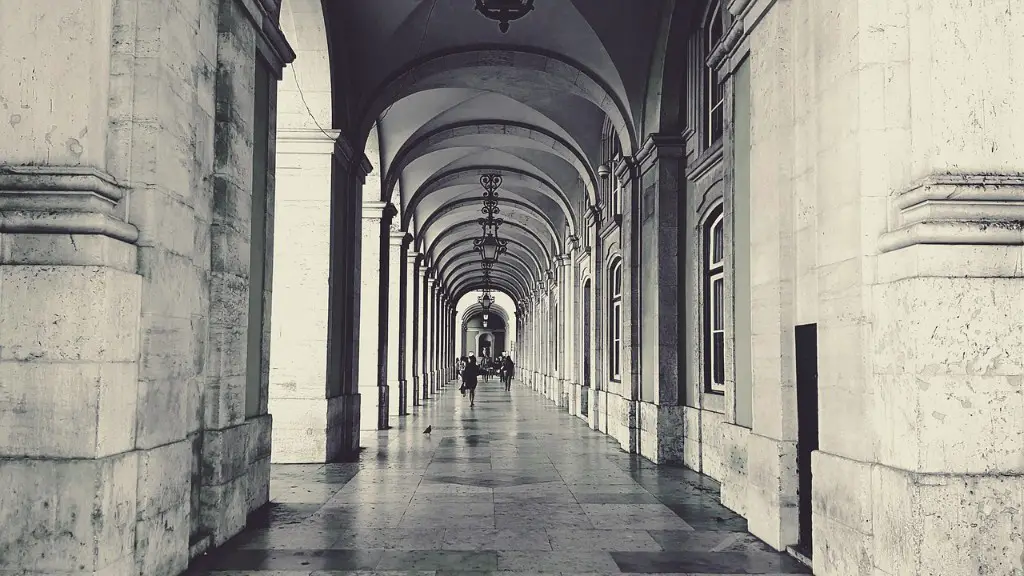Origins of Gothic Architecture
Gothic architecture was born in the twelfth century, when Romanesque architecture was becoming out of fashion and new trends like rib vaulting and gargoyles began to appear in the designs of churches and other public buildings. Gothic architecture began to spread across Europe, and its popularity increased throughout the medieval period, culminating in the late Gothic period in the fifteenth century. The most iconic example of Gothic architecture, the Notre Dame Cathedral in Paris, was built in this period.
The Gothic style emphasised verticality, with soaring spires, pointed arches and stained glass windows. These features brought a sense of eeriness and grandeur to the structures they decorated. The rib vaults and flying buttresses of Gothic cathedrals allowed them to be built higher and more complexly than any other building types of the period. Gothic structures were also highly decorated and lavishly embellished.
The driving force behind the emergence and prevalence of Gothic architecture was the Christian Church. It provided a major impetus for the development of the style, as it was closely connected to the ideology and functions of Christian belief. Gothic architecture was closely associated with the Catholic church, as its characteristic features were thought to better reflect the religious principles of the Catholic faith. This was reflected in the highly decorative and ornate nature of Gothic architecture.
The man credited with being the “Father of Gothic Architecture” is Abbot Suger of St. Denis, France. In the late 11th and early 12th centuries he initiated a project to rebuild the abbey at St. Denis using the newly developing Gothic style. Suger’s vision was to remodel the building from an austere Romanesque abbey into a bright, soaring Gothic cathedral filled with light, which he believed to be more reflective of divine truth. From this initial project, Gothic architecture began to emerge as a popular style throughout Europe.
Most of the building principles used in later Gothic structures originated with Abbot Suger’s project at St. Denis. He was the first to use the combination of rib vaults and flying buttresses that would come to typify Gothic architecture and he also developed the use of pointed arches in his designs. His creative approach to design set the tone for the development of the Gothic style in other areas.
The Gothic style would spread from France across Europe, becoming ever more refined in the process. Gothic architecture was used primarily in the construction of churches, but also featured in royal residences, castles, fortresses and other public buildings. It had an immense impact on the architecture of latter medieval period, introducing features and designs that would endure throughout the centuries.
Influence of Gothic Architecture
Gothic architecture had an immense impact on the visual landscape of Europe in the Medieval period. Not only did it provide a stunning backdrop to churches and other public buildings, but it also encouraged a spiritual atmosphere with its soaring spires and brightly coloured glass windows. Its emphasis on verticality and its intricate designs also set it apart from other medieval styles.
The legacy of Gothic architecture remains present today in the form of the many Gothic churches and cathedrals that are still standing. These structures are highly regarded for their beauty and complexity, and have become iconic symbols of culture and history. Gothic architecture has also endured in other forms, with its vertical emphasis and ornamental details being incorporated in later Revivalist styles of architecture, such as Renaissance and Baroque.
Modern architecture also borrows from Gothic principles, with many contemporary buildings taking cues from some of the key elements of Gothic architecture, such as the pointed arch and rib vaults. It is also still popular in restoration projects, where architects often attempt to recapture the grandeur of medieval Gothic designs.
The influence of Gothic architecture is not just limited to architectural realms, however. It is also highly influential in fashion and art. Gothic designs and motifs are found in clothing and accessories, such as corsets and chokers, and in many forms of modern art and music. Gothic culture, which embraces horror, melancholy and erotica, has become a popular subculture amongst many people.
Gothic Revival
The Gothic Revival movement began in the late eighteenth century, with architects and designers inspired by the medieval designs of Gothic architecture and the Romantics’ fascination with the medieval past and its art and culture. Gothic Revival styles soon emerged across Europe and Great Britain, with the Gothic style being used on a wide range of buildings, from churches and public buildings to residences, allowing a new generation to experience some of the features of Gothic architecture.
The Gothic revival of the nineteenth century was predominantly a neo-Gothic movement, rather than a faithful recreation of Gothic architecture. This is evident in the use of more modern materials, such as iron, glass and cast iron, and in the incorporation of Classical elements, such as columns, domes and regular arches, into the designs. These changes made the Gothic Revival style appealing to a range of people, from those looking for authenticity to those seeking something new.
One of the most renowned examples of Gothic Revival architecture is the Palace of Westminster, the home of the UK Parliament. Built in the early nineteenth century, it is a perfect embodiment of the Gothic revival, with its iconic towers, ribbed vaults and intricate designs combining Gothic elements with more modern materials and Neo-Classical features. It is a symbol of the mutability of the Gothic style and its continued appeal in modern times.
The Gothic revival also spread to the United States, with many cities, such as New York and Boston, boasting Gothic inspired structures. The iconic St Patrick’s Cathedral in New York is a classic example of the lasting appeal of Gothic revival, with its soaring spires and intricate stone detailing. Gothic architecture had an immense influence on the visual landscape of the nineteenth century, allowing a new generation to experience some of the features of the Gothic style.
Modern Gothic Architecture
Gothic architecture is still popular today, with modern architects continually borrowing from its principles and making creative use of its designs and techniques. Architects often attempt to recreate the feeling of grandeur and eeriness that Gothic architecture brought to medieval Europe, incorporating its vertical emphasis, pointed arches and intricate motifs.
Notable modern examples of Gothic architecture include the Barclays Center in New York, designed by architect Frank Gehry, with its distinctive arches, ribbed vaults and pointed towers, and the Capitol Building in Washington DC, with its intricate designs and ornate stone detailing.
Gothic architecture has also inspired a new generation of contemporary architects, who attempt to combine traditional Gothic style with modern materials and sensibilities. Renowned architects such as Frank Gehry, Zaha Hadid and Daniel Libeskind have all based the designs of their buildings on the principles of Gothic architecture, often making creative use of its characteristic features.
This shows that Gothic architecture is still alive and relevant to contemporary design. Its influence can be seen in many modern buildings, with its iconic features allowing architects to create structures that simultaneously draw from traditional designs and embody contemporary sensibilities. It is a style that has endured for centuries and its legacy lives on in some truly incredible structures.
Conclusion of Gothic Architecture
Gothic architecture has been an immensely influential style of architecture for centuries. It originated with the project of Abbot Suger at St. Denis, France, and it was soon spread across Europe, becoming a major trend in the medieval period. Its impact endured throughout the centuries and continues to be felt today, with Gothic principles and designs inspiring architects to create modern and innovative structures. From churches to public buildings and residences, Gothic architecture has had an immense influence on the visual landscape of Europe and the world.




